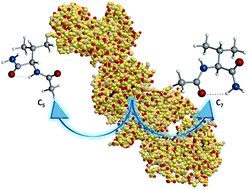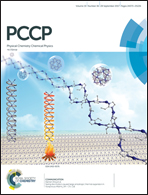The role of amino acid side chains in stabilizing dipeptides: the laser ablation Fourier transform microwave spectrum of Ac-Val-NH2†
Abstract
The steric effects imposed by the isopropyl group of valine in the conformational stabilization of the capped dipeptide N-acetyl-L-valinamide (Ac-Val-NH2) have been studied by laser ablation molecular beam Fourier transform microwave (LA-MB-FTMW) spectroscopy. The rotational and quadrupole coupling constants of the two 14N nuclei determined in this work show that this dipeptide exists as a mixture of C7 and C5 conformers in the supersonic expansion. The conformers are stabilized by a C![[double bond, length as m-dash]](https://www.rsc.org/images/entities/char_e001.gif) O⋯H–N intramolecular hydrogen bond closing a seven- or a five-membered ring, respectively. The observation of both conformers is in good agreement with previous results on the related dipeptides containing different residues, confirming that the polarity/non-polarity of the side chains of the amino acid is responsible for the conformational locking/unlocking. The voluminous isopropyl group is not able to prevent the less stable C5 conformer from forming but it destabilizes the C
O⋯H–N intramolecular hydrogen bond closing a seven- or a five-membered ring, respectively. The observation of both conformers is in good agreement with previous results on the related dipeptides containing different residues, confirming that the polarity/non-polarity of the side chains of the amino acid is responsible for the conformational locking/unlocking. The voluminous isopropyl group is not able to prevent the less stable C5 conformer from forming but it destabilizes the C![[double bond, length as m-dash]](https://www.rsc.org/images/entities/char_e001.gif) O⋯H–N interaction.
O⋯H–N interaction.



 Please wait while we load your content...
Please wait while we load your content...